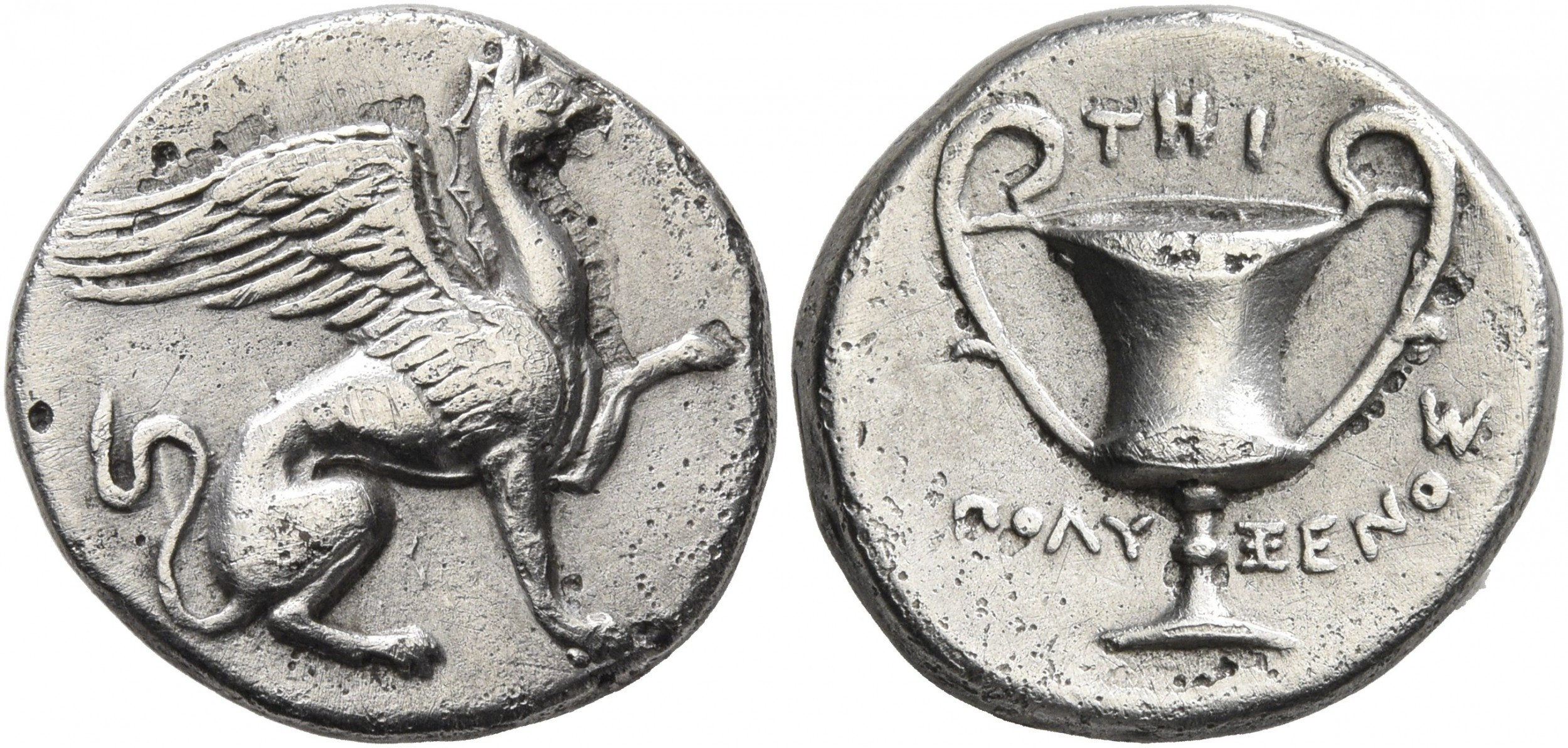Teos, silver, drachms (griffin/cantharus) (370-360 BCE)
From SILVER
(Redirected from S 1031 - Teos, silver, drachms (370-360 BCE))
370 BCE - 360 BCE Silver 305 kg
Description
| ObverseInscription or printing placed on the obverse.: | Griffin seated right, left forepaw raised. |
| ReverseInscription or printing placed on the reverse.: | THI/ ΠΟΛΥ-ΞΕΝΟΣ (Greek).Kantharos |
Mint and issuing power
| MintIdentifies the place of manufacture or issue of a numismatic object.: | Teos | Ancient regionAncient region.: | Ionia | Modern countryModern country: Turkey | AuthorityIdentifies the issuing power. The authority can be "pretended" when the name or the portrait of X is on the coin but he/she was not the issuing power. It can also be "uncertain" when there is no mention of X on the coin but he/she was the issuing power according to the historical sources: |
Chronology
| FromIdentifies the initial date in a range assigned in a numismatic context. | 370 BCE | toIdentifies the final date in a range assigned in a numismatic context.. | 360 BCE | PeriodTime period of the numismatic object.: Classical 480-323 BC |
Physical description
| MetalThe physical material (usually metal) from which an object is made.: | Silver |
Median weightMedian of the weights of numismatic objects (in grams). in grams | 3.50 | DenominationTerm indicating the value of a numismatic object. Examples: tetradrachm, chalkous, denarius.: | drachma |
StandardStandard.: |
Image

S 1031 Teos Drachm 370-360.jpg [1]
References
| Die study referencePublication of the study: | Kinns 19801Kinns 1980, p. 506 (period I, phase 2, AR IVA, D11/D13-R1/R5). | ||
| Coin series referenceReference to coin series study: | |||
| Coin series web referenceCoin series web references: | |||
Obverse dies distribution
| FrequencyFrequency of specimen in distribution. ᵖ | Number of obversesNumber of obverse dies. ᵖ (o) | % (o) | Number of coinsNumber of coins. (n) | % (n) | Die nameName(s) of the die(s). |
| 1 | 1 | 33.33 | 1 | 14.29 | |
| 3 | 2 | 66.67 | 6 | 85.71 | |
| Total | 3 of 3 | 100 | 7 of 7 | 100 |
Reverse dies distribution
no distribution is available
Quantification
| Number of obversesNumber of obverse dies. ᵖ (o) | 3 | Number of singletons (o1)The number of singleton coins. ᵖ | 1 |
| Number of reverse diesNumber of reverse dies. (r) | 5 | Number of coinsNumber of coins. (n) | 7 |
| Coins per obverse dieNumber of coins per obverse die. (n/o) | 2.33 | Coins per reverse dieNumber of coins per reverse die. (n/r) | 1.4 |
| Reverse per obverse ratioRatio of obverse dies divided by reverse dies. (r/o) | 1.67 | Percentage of singletons (o1)number of coins (n) divided by the number of singletons (o1) ᵖ | 33.33 % |
| Original number of dies (O) (Carter 1983 formula)The estimation of the number of coins according to Carter 1983 ᵖ | 4.36 | Coins struck if 20,000 as average productivity per dieCoins made if the average productivity for obverses (according to Carter) is 20,000. ᵖ | 87,200 |
| Original number of dies (O) (Esty 2011 formula)The estimation of the number of coins according to the singleton formula in Esty 2011 ᵖ (O) | 5.25 | Survival rate if 20,000 as average productivity per dieSurvival rate if average productivity is 20,000. ᵖ | 0.00008 |
| Coverage (o = % of O) (Esty 1984 formula)Esty 1984 - coverage (% of O) ᵖ (o = % of O) | 85.71% | Die productivity if survival rate 1/2,000Average productivity if survival rate is 1/2,000. ᵖ | 3,211.01 |
| Weight of silver (in kg) if 20,000 coins per die (O = Carter formula)Carter 1983 * Median weight * 20000 (*10 if gold or electrum) ᵖ | 305 kg <br /> 305 kg | Die productivity if survival rate 1/5,000Average productivity if survival rate is 1/5,000. ᵖ | 8,027.52 |
Remarks
Most likely one single workstation
References
- ^ Kinns, Philip (1980), Studies in the coinage of Ionia: Erythrae, Teos, Lebedus, Colophon, c. 400-30 B.C., unpublished PhD thesis, Cambridge University.